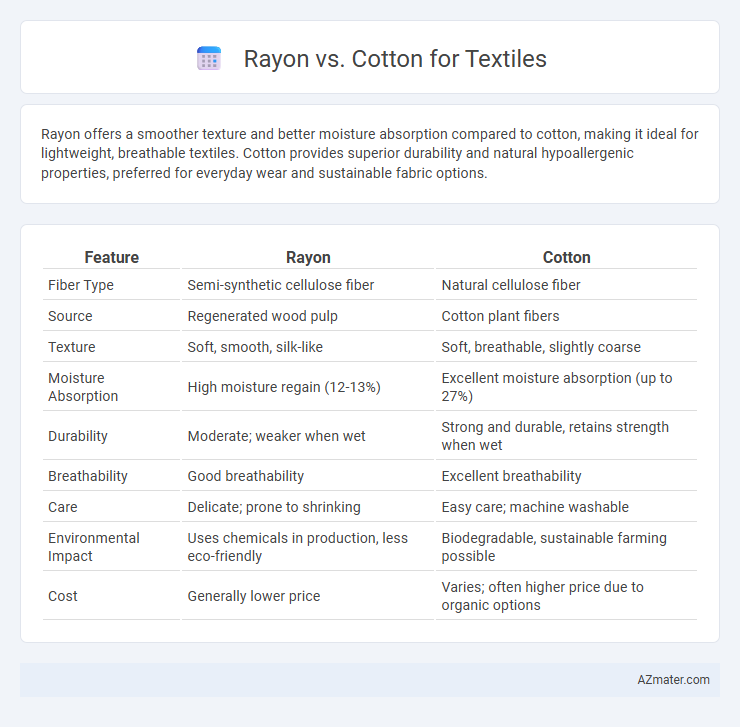Rayon offers a smoother texture and better moisture absorption compared to cotton, making it ideal for lightweight, breathable textiles. Cotton provides superior durability and natural hypoallergenic properties, preferred for everyday wear and sustainable fabric options.
Table of Comparison
| Feature | Rayon | Cotton |
|---|---|---|
| Fiber Type | Semi-synthetic cellulose fiber | Natural cellulose fiber |
| Source | Regenerated wood pulp | Cotton plant fibers |
| Texture | Soft, smooth, silk-like | Soft, breathable, slightly coarse |
| Moisture Absorption | High moisture regain (12-13%) | Excellent moisture absorption (up to 27%) |
| Durability | Moderate; weaker when wet | Strong and durable, retains strength when wet |
| Breathability | Good breathability | Excellent breathability |
| Care | Delicate; prone to shrinking | Easy care; machine washable |
| Environmental Impact | Uses chemicals in production, less eco-friendly | Biodegradable, sustainable farming possible |
| Cost | Generally lower price | Varies; often higher price due to organic options |
Introduction to Rayon and Cotton
Rayon is a semi-synthetic fiber made from regenerated cellulose derived from wood pulp, offering a silky texture and excellent breathability ideal for lightweight clothing. Cotton, a natural fiber harvested from the seed hairs of the cotton plant, is renowned for its softness, durability, and moisture absorption, making it a staple in textile manufacturing. Both fibers are extensively used in the fashion industry, with rayon often chosen for its smooth drape and cotton for its comfort and versatility.
Origins and Production Processes
Rayon, a semi-synthetic fiber derived from cellulose primarily sourced from wood pulp, undergoes a chemical-intensive production process including steaming, chemical treatment, and spinning into fibers. Cotton, a natural fiber harvested from cotton plant bolls, requires mechanical harvesting, cleaning, and carding before being spun into yarn. The contrasting origins, with rayon originating from processed natural polymers and cotton being directly harvested from plants, define their distinctly different production methods in textile manufacturing.
Fiber Structure and Composition
Rayon is a semi-synthetic fiber made from regenerated cellulose derived from wood pulp, exhibiting a smooth, uniform fiber structure that enhances its softness and drape. Cotton is a natural fiber composed primarily of cellulose with a convoluted, ribbon-like fiber structure that provides breathability and durability. The differences in fiber morphology and chemical composition influence their moisture absorption, strength, and feel in textile applications.
Texture and Feel Comparison
Rayon offers a smooth, silky texture that feels soft and cool against the skin, making it ideal for lightweight, breathable garments. Cotton features a natural, slightly coarse texture that provides durability and a comfortable, breathable feel suitable for everyday wear. The moisture-wicking properties of rayon contribute to its luxurious, drapey touch, while cotton's fibrous structure ensures a more textured, absorbent finish.
Moisture Absorption and Breathability
Rayon exhibits excellent moisture absorption, often surpassing cotton by absorbing up to 90% of its weight in water, which enhances comfort in humid conditions. Cotton, known for its natural breathability, allows air circulation and wicks moisture away from the skin effectively, making it ideal for everyday wear. While rayon offers superior moisture retention, cotton's combination of breathability and moisture-wicking properties ensures better overall ventilation in textile applications.
Durability and Longevity
Rayon fibers, derived from regenerated cellulose, tend to have moderate durability but are more prone to weakening when exposed to water or friction compared to cotton. Cotton, a natural cellulose fiber, offers superior longevity due to its stronger tensile strength and resistance to wear over time, making it ideal for durable textile applications. Fabrics made from cotton generally maintain their shape and texture longer, while rayon requires more careful handling to preserve its integrity.
Environmental Impact and Sustainability
Rayon, derived from cellulose fibers typically sourced from wood pulp, has a significant environmental impact due to deforestation and chemical-intensive production processes that contribute to water and air pollution. Cotton cultivation requires extensive water usage and pesticides, leading to soil degradation and groundwater depletion but is biodegradable and renewable. Sustainable alternatives in textile production involve organic cotton and closed-loop rayon processes, which minimize ecological footprints and promote eco-friendly manufacturing practices.
Common Uses in the Textile Industry
Rayon is widely used in the textile industry for its silk-like feel and versatility in making dresses, linings, and blouses, offering excellent drape and breathability. Cotton remains a dominant natural fiber favored for its softness, durability, and moisture-wicking properties, commonly found in casual wear, denim, and home textiles such as towels and bed linens. Both fibers are integral to fashion and home textiles, with rayon often chosen for affordability and aesthetic appeal, while cotton is preferred for comfort and sustainability.
Care and Maintenance Tips
Rayon requires gentle care with hand washing or dry cleaning to prevent shrinking and fabric damage, while cotton is more durable and machine washable, making it easier to maintain. Both fabrics benefit from air drying to preserve their texture and avoid excessive wear from high heat in dryers. Using mild detergents and avoiding bleach will extend the life of rayon and cotton textiles, ensuring color retention and fabric strength.
Choosing Between Rayon and Cotton
Choosing between rayon and cotton depends on factors such as breathability, texture, and care requirements. Cotton, a natural fiber, offers superior breathability and durability ideal for casual wear, while rayon, a semi-synthetic fiber, provides a silky texture and drapes well, making it suitable for dressier garments. Consider environmental impact; cotton cultivation demands significant water usage, whereas rayon production involves chemical processing but can be more sustainable if derived from responsibly sourced cellulose.

Infographic: Rayon vs Cotton for Textile
 azmater.com
azmater.com